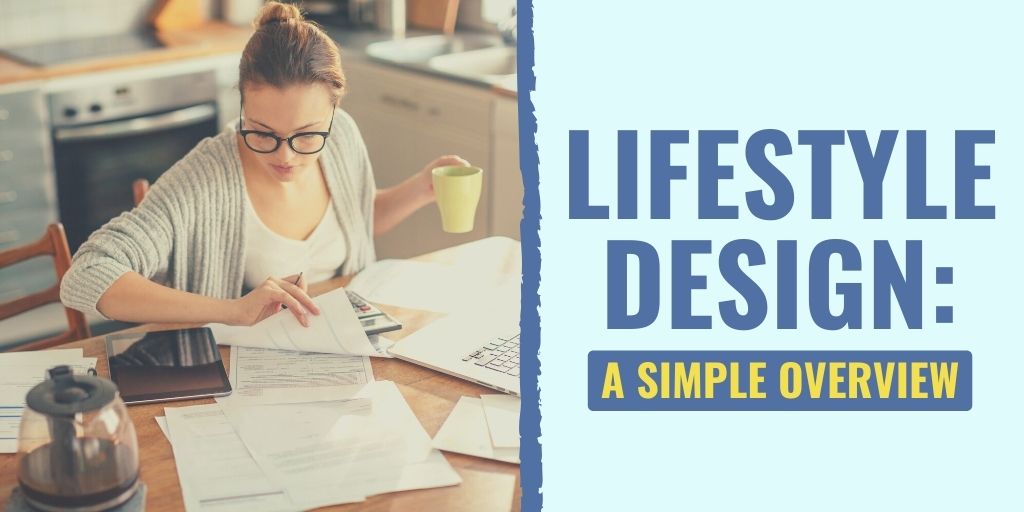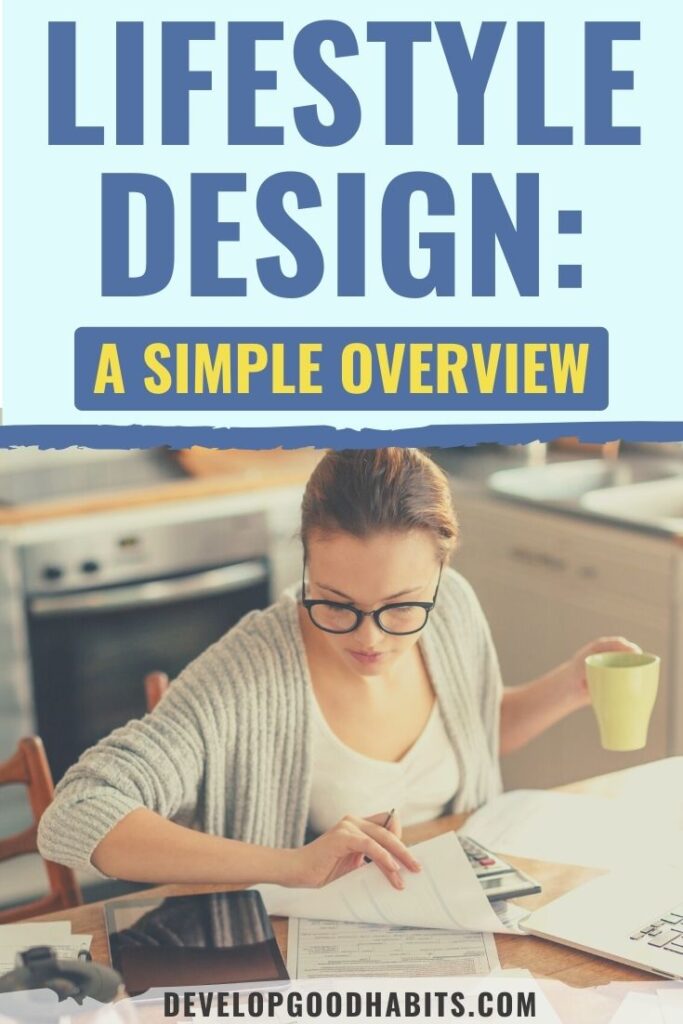There might be affiliate links on this page, which means we get a small commission of anything you buy. As an Amazon Associate we earn from qualifying purchases. Please do your own research before making any online purchase.
If you’re like me, you’ve designed your living and working spaces in a way that suits you best.
You want them to be functional areas, but also have elements that reflect your personality and the things that are important to you–such as displayed photographs of family and friends.
You create your space on your own terms because it is where you spend most of your time.
But have you ever thought about how you design the less tangible things in your life, like landing your dream job, who your friends are, the kind of person you want to be, and how you want to spend your time?
Designing your life on your own terms makes a lot of sense when you think of it in this way. You don’t have other people organizing your desk drawers in a way that they think works best for you, so why would anyone else organize your life?
In this article, we are going to talk about where the concept of lifestyle design originated and how you can get started with designing your own lifestyle.
We will look at specific strategies that you can use to plan your life on your own terms as well as resources that will be helpful with getting you started.
First, let’s take a deeper look into what lifestyle design is and where the idea came from.
What Is Lifestyle Design?
Think about the typical progression of a lifetime. People go to school until they’re in their mid-20s (or thereabout), and then start their professional career.
Fast forward about 40 years and it’s time to retire and spend your time doing what you really want to do with your life.
And on a weekly basis, you work 40+ hours a week to have 2 days off to complete the tedious tasks of life–grocery shopping, laundry, food prep, etc.
Once retirement comes, your prime has passed. Your energy and physical abilities are declining, and you have essentially deferred really “living” the life you want until it’s almost too late to enjoy some of the more amazing things that life has to offer.
Designing your own lifestyle has become increasingly popular since Time Ferriss published his book, The 4-Hour Workweek. In his book, Ferriss does an excellent job of challenging people to rethink this typical 9-5 way of life and reevaluate how to make the best use of their time.
He strongly supports using the digital technology that is now available to us to work efficiently and take advantage of having the ability to work outside of a typical office setting.
As a side note, the video below provides a a simple 9-step process about building habits that you can immediately implement as part of your lifestyle design.
Lifestyle design isn’t about avoiding doing work so you can spend your whole life lounging on the beach.
Having more leisure time won’t necessarily bring you more satisfaction in life, but designing your life around work that is meaningful to you can give you the sense of purpose you need in order to be happy in life.
Lifestyle design is about setting up your life in a way that allows you to work on your own terms, its definition is really different for everyone. It’s about living with a sense of intention that allows you to align your actions and behaviors with your values and goals.
It’s about having your own ideals and living according to them rather than following someone else’s.
It’s not about getting out of doing work, but rather setting up your lifestyle so you can get the most satisfaction and fulfillment out of the work that you do.
The point here is that lifestyle design is about looking at your goals and thinking in unconventional ways about how to make your ideal life possible sooner rather than later.
It’s about taking charge of your life instead of letting society tell you what to do–so you will have to be prepared to decide exactly how doing that will work for you.
But, assuming that the idea of living your life more on your own terms appeals to you, let’s look at some strategies you can use to get started with this practice.
How to Get Started Designing Your Lifestyle
Oftentimes when people think about starting a lifestyle design, their mind automatically goes to quitting their job, finding a source of passive income, and then spending their days doing just…whatever…as their money grows on its own.
Not only is this not a strategic way to go about lifestyle design, it’s also not sustainable. So let’s look at how you should actually approach this idea before you walk out of your cubicle.
1. Why?
What is your purpose in life? What are your values, needs, sources of motivation (Please link to DGH article: What are the differences between intrinsic and extrinsic motivation?) , and your personal strengths?
One activity you can do to help reflect on these things is to write a personal mission statement. Completing this task is a great way to develop a basis for determining the things that you want to get out of life and why you believe your goals are important.
Your mission statement can give you a sense of direction when it comes to your habits, everyday routines, and the choices that you make.
You should review your personal mission statement every so often because your values, goals, and circumstances will change with time and you want to make sure that you’re adjusting your actions accordingly.
2. What do you want out of life?
People seek a sense of social acceptance–to the point of hiding their true identity.
For example, it’s socially acceptable to go to college and then become an accountant. But, if you share your truth with people that you’re joining a band and traveling around the country looking for opportunities to play your music…you might get some raised eyebrows.
However, going with option A of working with numbers at a desk all day can leave you feeling a sense of guilt for denying your true self.
In the interest of being comfortable with your ultimate life choices, you have to be brave enough to share your passions with other people. You need to own who you are in order to make the commitment to yourself that you will remain dedicated to the life that you design.
When you’re considering your purpose for creating a lifestyle design, you will naturally consider what you want for your life rather than what other people may try to convince you what’s best for you.
By taking a self-inventory of your wants and needs, you will be greatly increasing your chances for success. You have to know yourself as well as possible in order to design your lifestyle on your own terms.
When you tell other people about the ways in which you want to make a change in the world, you’ll automatically look and sound more enthusiastic than when you’re talking about a current job that is unfulfilling but pays your bills.
Your excitement will be evident and lend its way toward an engaging conversation. You may even inspire the other person to design their own lifestyle as well.
Finally, when you’re figuring out what you want to get out of life, you also have to determine the things you don’t want, which starts by doing a purge. The act of purging will help you recognize the things that are important to you and the things that aren’t.

Purging doesn’t only involve getting rid of unused possessions,it also allows you to eliminate any relationships, obligations, and stale thoughts that don’t really matter in your life anymore.
Anything that doesn’t have a productive function in the lifestyle design that you’re aiming to have can be let go because all it’s doing is holding you back.
The act of purging will allow you to start reframing your mindset to one that aligns with the new story that you’re writing for your life.
3. Calculate your costs.
Do you know how much money you need to bring in each month to live the lifestyle that you want? While you most likely know your annual salary, you might not realize your annual expenditures.
Knowing how much money you spend in a year is critical because it will give you better insight on how much money you need to bring in to live your ideal lifestyle.
To give yourself an estimate, add up all of the expenses that you paid last year, including credit card payments, cash withdrawals, monthly payments, food expenses, etc.
Once you have that number, determine how much of a financial cushion you have–do you have enough money to live your current lifestyle for a year without having any money coming in? This is where the next step comes into play…
4. Become financially independent.
The first step to becoming financially independent is to pay off any revolving debt. The amount of interest that you pay each month toward your credit cards if your balance remains high can be jarring.
You will also want to start building a cushion of savings for yourself.
While saving often seems overwhelming, planning on how you can save will help you find ways that you can line up your spending habits with your lifestyle design goal. And planning is certainly a critical component to becoming financially independent.
After you have a plan in hand for saving, you have to create a budget (and stick to it) to ensure that you’re following through with your intended progress on savings. So, measure your income, deduct your expenses, and determine how you can redirect the remainder toward your goals.
This means you need to be spending less than you’re earning–which could possibly involve adhering to a lower standard of living than you’ve become accustomed to.
However, if you want to design the lifestyle of your dreams, you need to let go of any dependence you have on any type of external financial support.
5. Create a source of income that isn’t tied to a specific location.
If you’re “location independent”, it means that you can live and work wherever you want to. You’re not tied to an office or a certain city that is the home base for your company.
When you think of people who have this luxury, your mind probably goes to bloggers and consultants of some sort. But there are a lot of careers that can allow you to be location independent.
Here are some examples:
Even teachers have the opportunity to be location independent due to the advancement of technology that has allowed educators to effectively teach classes online while still maintaining an emotional connection with their students through video interactions.

If you’re not tied to a specific location, you’re able to open up your opportunities and gain the freedom that you need to go anywhere in the world that will help you live the lifestyle that you’ve determined is the best fit for you.
6. Start living it.
Once you know your purpose, you know your realistic budget, you have the financial and regional freedom to make your own choices in those regards, you simply need to start aligning your habits with the design you’ve created.
Embrace the idea of developing your own habits rather than copying someone else’s. Doing this will help ensure that you’re able to stick to your habits because they will be in line with your unique lifestyle choices.
To ensure your habits are parallel to your lifestyle design, assess your current habits and determine which ones support your new way of life and which ones are futile.
Then, identify the keystone habits that you can start practicing every day that will support your lifestyle design and your ultimate goals. This could mean amping up an existing habit, starting something new, or even replacing a current bad habit with one that is more helpful.
Committing yourself to appropriate daily habits will increase your determination for making the necessary changes in your life that are required for your lifestyle design.
Now that you’re ready to start designing your own lifestyle, let’s look at some additional resources you can use to help you through this process.
Additional Resources for Designing Your Lifestyle
The 4-Hour Work Week – Tim Ferriss teaches readers in this book how (and why) to do away with outdated methods for success (working 40+ hours per week until retirement, etc.) and replacing this traditional schedule with a new way of living that allows you to live the life you want.
His method allows readers to free up a lot of time during the week to spend on doing the things that they actually want to do.
Here are the Top 12 Lifestyle Design Blogs.
Final Thoughts on Lifestyle Design
The first step to designing your lifestyle is to figure out what you want out of life. Even if you only have a broad idea, you’re probably ahead of most other people.
Do what you can to start learning about yourself so you can design your lifestyle to line up with your values and ideals.
You can develop this necessary sense of self-awareness by taking an objective look at your life, practicing reflection through journaling, being mindful of your everyday behaviors, and even turning to friends you trust to help give you an outside look at who you are.
Your self-awareness helps determine your habits, both positive and negative. As you continue to learn about yourself, you will be able to recognize your habits that have the greatest impact on helping you achieve your goals and live the life that you want.
Now, if you're looking for more inspiration to get started on your lifestyle design, check out these articles:
- 13 Steps to Stop Making Excuses and Own Your Actions
- 31 Songs About Freedom and Living an Independent Life
- What To Do With My Life? A Simple Guide to Find Out
Finally, if you want to take your goal-setting efforts to the next level, check out this FREE printable worksheet and a step-by-step process that will help you set effective SMART goals.

Connie Mathers is a professional editor and freelance writer. She holds a Bachelor's Degree in Marketing and a Master’s Degree in Social Work. When she is not writing, Connie is either spending time with her daughter and two dogs, running, or working at her full-time job as a social worker in Richmond, VA.


